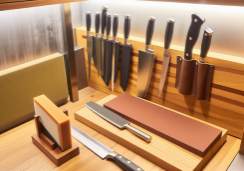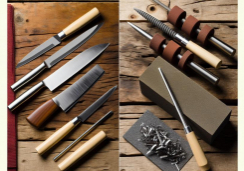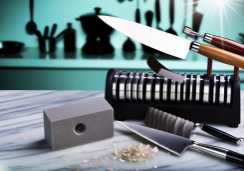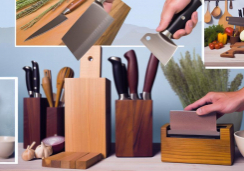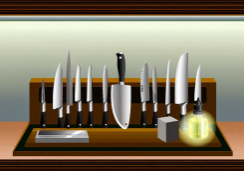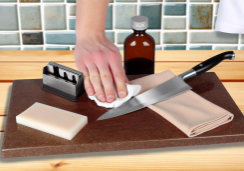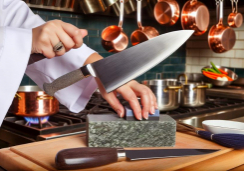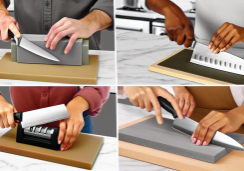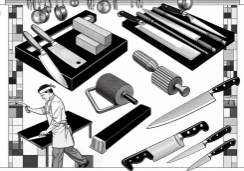What Are Your Options for Sharpening Knives at Home?
Just as a master swordsman must keep their blade sharp to ensure victory, you too must maintain the keen edge of your kitchen knives to ensure culinary success.
You're faced with an array of options, from the age-old whetstone, with its meditative strokes, to the modern convenience of electric sharpeners that promise a quick fix.
Perhaps you'll find solace in the rhythmic glide of a knife against a honing steel, or maybe you'll opt for the simplicity of a manual sharpener that fits neatly in your kitchen drawer.
Each method has its merits and pitfalls, and as you weigh them against your needs, consider not only the sharpness you desire but the journey you'll take to maintain the tools that play such a crucial role in your kitchen artistry.
Will you choose tradition or technology, speed or precision? The answer lies in understanding the subtleties of each option.
Whetstone Sharpening Technique
To achieve a razor-sharp edge on your knives, you'll need to master the art of whetstone sharpening, a technique that involves a series of precise strokes against a stone's gritty surface. Whetstones, also known as sharpening stones, come in various grits—coarse, medium, and fine. You'll use these progressively to refine the blade's edge.
Start with the coarse grit to reshape or repair any nicks. Soak the stone in water for about 10 minutes, if it's a water stone, or use honing oil for an oil stone. Place it on a stable surface. Hold the knife at a 20-degree angle to the whetstone, applying light, consistent pressure as you glide the blade across the stone in a sweeping motion, from heel to tip. Repeat this process on both sides of the blade.
Shift to a medium grit to refine the edge, following the same technique. Finally, use the fine grit stone to polish the edge to a fine point. Consistency is key. Maintain the angle and pressure throughout the process, and don't rush.
Regularly sharpening your knives with a whetstone will ensure they're always ready for the precise cuts you demand in your culinary endeavors.
Honing Steel Basics
After sharpening your knives with a whetstone, regularly using a honing steel will maintain the blade's edge and ensure peak performance with every cut. Honing steels, often mistaken for sharpeners, are actually aligning tools. They straighten the edge of a knife, correcting the micro-sized bends and nicks that occur with regular use. It's important to understand that honing doesn't remove metal from the blade like sharpening does; instead, it repositions the existing edge to its optimal angle.
To evoke the sense of meticulous care and precision that honing embodies, consider these critical aspects:
- Frequency: Honing after every couple of uses keeps your knife's edge in perfect alignment, giving you the confidence of a professional chef in your own kitchen.
- Technique: Mastering the right angle and pressure involves a harmonious balance, contributing to the longevity of your cherished cutlery.
- Material: Choose a honing steel that complements your knife set — a symbol of your dedication to preserving the soul of your culinary tools.
Manual Knife Sharpeners Use
While honing steels realign your knife's edge, manual sharpeners are essential for actually grinding away the metal to create a new sharp edge when the blade becomes dull. These sharpeners often feature one or more slots with abrasive materials like diamond, ceramic, or tungsten carbide that remove a small amount of steel from your knife to restore its sharpness.
To use a manual knife sharpener, you'll first need to place it on a stable surface. Hold the sharpener with one hand and the knife handle with your other hand. Insert the knife blade into the appropriate slot, starting with the coarsest grind if your sharpener has multiple options. Pull the knife through the slot with a firm, steady motion, being careful not to press down too hard—let the sharpener do the work for you. Repeat this process several times, checking the blade's sharpness periodically.
Once you've achieved the desired sharpness with the coarse grind, move to the finer slot to polish and hone the edge. This step is crucial for a razor-sharp finish. Remember, consistent angle and pressure are key for an evenly sharpened blade.
After sharpening, always clean the knife and sharpener to remove any metal filings.
Electric Sharpeners Advantages
Switching from manual to electric knife sharpeners, you'll notice a significant reduction in the effort and time required to maintain a sharp blade. Electric sharpeners offer a level of convenience and efficiency that can transform the mundane task of knife sharpening into a quick, almost effortless process. With their precision-engineered guides and consistent grinding angles, you're not just sharpening a knife; you're enhancing your entire cooking experience.
Consider these compelling advantages of electric sharpeners:
- Consistent Results: Achieve uniformly sharp edges every time without the guesswork. There's no substitute for the satisfaction of slicing through ingredients with ease.
- Speed: In the time it takes to manually sharpen one knife, you could have a whole set done, giving you more time to immerse yourself in the joy of cooking.
- Minimal Skill Required: Say goodbye to the steep learning curve of manual sharpening. Even if you're a novice, you'll feel like a pro with the push of a button.
Stropping for Edge Maintenance
Having explored the automated ease of electric sharpeners, let's now consider stropping, an essential technique for maintaining the razor-sharp edge of your knives between more intensive sharpening sessions. Stropping doesn't actually sharpen by removing material from the edge; instead, it realigns the microscopic teeth of the blade that can become bent through use.
You'll need a strop, which is typically a strip of leather, although other materials like canvas or denim can also serve in a pinch. To properly strop a knife, hold the blade at the same angle as the cutting edge—usually about 20 degrees for most kitchen knives—and gently draw it across the strop away from the cutting edge, alternating sides with each stroke. This process smooths the blade and corrects the edge without grinding away steel, preserving the knife's lifespan.
Stropping is a skill that requires some practice to perfect, but once you've got the hang of it, you'll find it's a quick and efficient way to touch up your knives. It's particularly useful for those prized kitchen knives that you want to keep in top condition, or for any blade that sees regular use.
Can I Use Household Items to Sharpen My Knives at Home?
Yes, you can use household items to sharpen your knives at home. Some of the best knife sharpening techniques include using a coffee mug, sandpaper, or a honing rod. These items can help maintain the sharpness of your knives without the need for professional equipment.
Conclusion
In conclusion, you've got a variety of options to keep your knives razor-sharp at home. Whether you're using a whetstone with practiced technique, a honing steel for quick maintenance, a manual sharpener for convenience, or an electric sharpener for efficiency, each method serves a purpose.
Don't forget to finish with stropping to polish and align the edge. Choose the method that best fits your skills and needs to ensure your knives are always in top condition.

